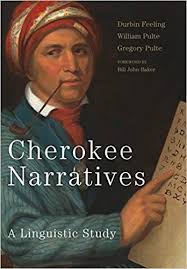Yes, this book consists both of Cherokee narratives and of a linguistic study. Here are eighteen traditional stories told in a down-to-earth way by elders both of the Eastern Band and of the Cherokee Nation. That alone makes this a valuable and enjoyable book. Furthermore, each is presented in four ways: First each word is presented in the Cherokee syllabary and below that in the Cherokee language written with English characters, and below that in English. This is really helpful to the few people who know the Cherokee language and want to learn English and to the many who know English and want to learn Cherokee. The next section presents the syllabary and English morpheme by morpheme. Morpheme is a term for the smallest meaningful unit of language, for example, “outgoing” would be broken down into “out,” “go” and “ing.” Again this is useful to language learners and especially to linguists. Then the narrative is presented completely simply in the Cherokee syllabary. The fourth and last section presents it in English. Thus the book is enjoyable and useful even to those of us who have no interest in linguistics or even in learning another language. The primary authors, Durbin Feeling and William Pulte, have collaborated extensively for decades ever since they both lived in Tahlequah, Oklahoma. Both are now retired professors. Gregory Pulte is a graduate student at UT-Austin.
Norman: The University of Oklahoma Press, 2018. 228 pages with a Foreword by Bill John Baker, Principal Chief of the Cherokee Nation and References. Trade paperback.
